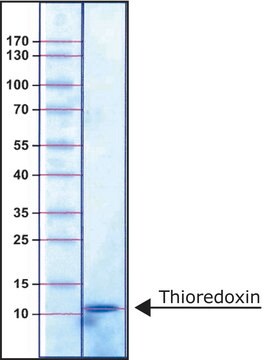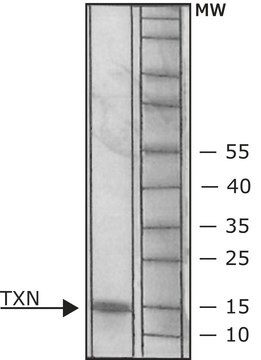T9698
Thioredoxin Reductase from rat liver
buffered aqueous glycerol solution, ≥100 units/mg protein (Bradford)
Sinónimos:
NADPH:Oxidised Thioredoxin Oxidoreductase, Thioredoxin: NADP+ Oxidoreductase
About This Item
Productos recomendados
biological source
rat liver
Quality Level
assay
≥90% (GE)
form
buffered aqueous glycerol solution
specific activity
≥100 units/mg protein (Bradford)
mol wt
55—67 kDa
technique(s)
activity assay: suitable
impurities
Glutathione reductase
solubility
water: soluble
suitability
suitable for molecular biology
UniProt accession no.
shipped in
dry ice
storage temp.
−20°C
Gene Information
rat ... Txnrd1(58819)
General description
Application
Biochem/physiol Actions
Unit Definition
Physical form
Storage Class
12 - Non Combustible Liquids
wgk_germany
WGK 1
flash_point_f
Not applicable
flash_point_c
Not applicable
ppe
Eyeshields, Gloves, multi-purpose combination respirator cartridge (US)
Certificados de análisis (COA)
Busque Certificados de análisis (COA) introduciendo el número de lote del producto. Los números de lote se encuentran en la etiqueta del producto después de las palabras «Lot» o «Batch»
¿Ya tiene este producto?
Encuentre la documentación para los productos que ha comprado recientemente en la Biblioteca de documentos.
Artículos
Oxidative stress is mediated, in part, by reactive oxygen species produced by multiple cellular processes and controlled by cellular antioxidant mechanisms such as enzymatic scavengers or antioxidant modulators. Free radicals, such as reactive oxygen species, cause cellular damage via cellular.
Nuestro equipo de científicos tiene experiencia en todas las áreas de investigación: Ciencias de la vida, Ciencia de los materiales, Síntesis química, Cromatografía, Analítica y muchas otras.
Póngase en contacto con el Servicio técnico





